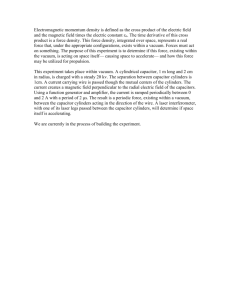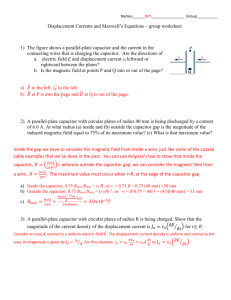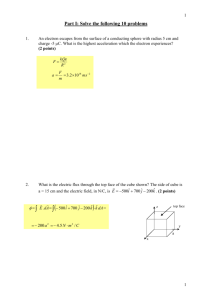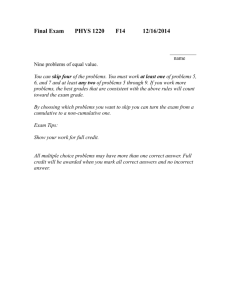AP Physics Review
advertisement
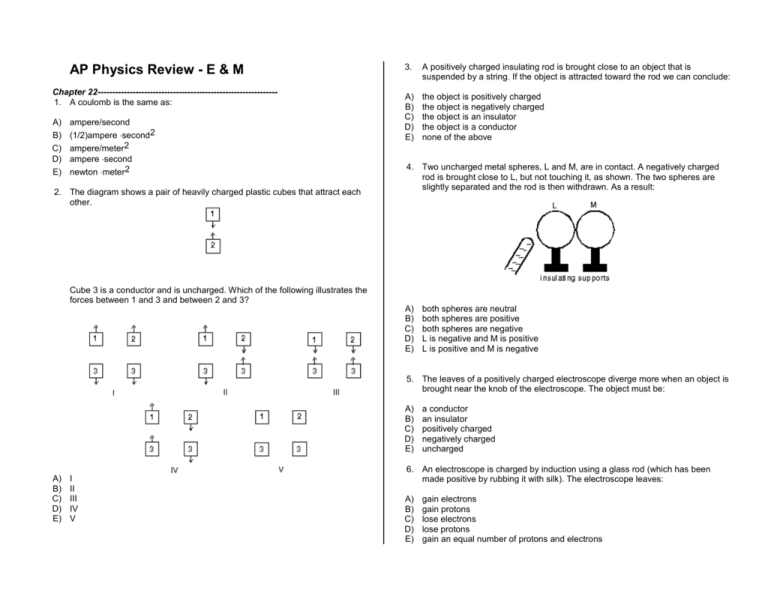
AP Physics Review - E & M Chapter 22-------------------------------------------------------------1. A coulomb is the same as: A) B) C) D) E) ampere/second (1/2)ampere second2 ampere/meter2 ampere second newton meter2 2. The diagram shows a pair of heavily charged plastic cubes that attract each other. 3. A positively charged insulating rod is brought close to an object that is suspended by a string. If the object is attracted toward the rod we can conclude: A) B) C) D) E) the object is positively charged the object is negatively charged the object is an insulator the object is a conductor none of the above 4. Two uncharged metal spheres, L and M, are in contact. A negatively charged rod is brought close to L, but not touching it, as shown. The two spheres are slightly separated and the rod is then withdrawn. As a result: Cube 3 is a conductor and is uncharged. Which of the following illustrates the forces between 1 and 3 and between 2 and 3? A) B) C) D) E) both spheres are neutral both spheres are positive both spheres are negative L is negative and M is positive L is positive and M is negative 5. The leaves of a positively charged electroscope diverge more when an object is brought near the knob of the electroscope. The object must be: A) B) C) D) E) A) B) C) D) E) I II III IV V a conductor an insulator positively charged negatively charged uncharged 6. An electroscope is charged by induction using a glass rod (which has been made positive by rubbing it with silk). The electroscope leaves: A) B) C) D) E) gain electrons gain protons lose electrons lose protons gain an equal number of protons and electrons Chapter 23-------------------------------------------------------------7. Experimenter A uses a test charge qo and experimenter B uses a test charge 2qo to measure an electric field produced by stationary charges. A finds a field that is: A) B) C) D) the same as the field found by B greater than the field found by B less than the field found by B either greater or less than the field found by B, depending on the masses of the test charges E) either greater or less than the field found by B, depending on the accelerations of the test charges 8. Two spheres, one with radius R and the other with radius 2R, surround an isolated point charge. The ratio of the number of field lines through the larger sphere to the number through the smaller is: A) B) C) D) E) 1 2 4 1/2 1/4 9. Choose the correct statement concerning electric field lines: A) B) C) D) E) field lines may cross field lines are close together where the field is large field lines point away from negative charge a point charge released from rest moves along a field line none of these are correct 10. Positive charge Q is uniformly distributed on a semicircular rod. What is the direction of the electric field at point P, the center of the semicircle? A) B) C) D) E) 11. An electric field exerts a torque on a dipole only if: A) B) C) D) E) the field is parallel to the dipole moment the field is not parallel to the dipole moment the field is perpendicular to the dipole moment the field is not perpendicular to the dipole moment the field is uniform 12. A charged oil drop with a mass of 2x10-4 kg is held suspended by a downward electric field of 300 N/C. The charge on the drop is: A) B) C) D) E) +1.5x10-6 C -1.5x10-6 C +6.5x10-6 C -6.5x10-6 C 0 Chapter 24-------------------------------------------------------------13. When a piece of paper is held with one face perpendicular to a uniform electric field the flux through it is 25 N m2/C. When the paper is turned 25 with respect to the field the flux through it is A) B) C) D) E) 0 12 N m2/C 21 N m2/C 23 N m2/C 25 N m2/C 14. Consider Gauss's law: ∫E dA = q/o. Which of the following is true? A) B) C) D) E) E must be the electric field due to the enclosed charge If q = 0 then E = 0 everywhere on the Gaussian surface If the charge inside consists of an electric dipole, then the integral is zero E is everywhere parallel to dA along the surface If a charge is placed outside the surface, then it cannot affect E on the surface 15. A) B) C) D) E) A 5.0-C point charge is placed at the corner of a cube. The total electric flux in N m2/C through all sides of the cube is: 0 7.1 104 9.4 104 1.4 105 5.6 105 16. A conducting sphere of radius 0.01 m has a charge of 1.0x10 -9 C deposited on it. The magnitude of the electric field in N/C just outside the surface of the sphere is: A) B) C) D) E) zero 450 900 4500 90,000 17. 10 C of charge are placed on a spherical conducting shell. A -3 C- point charge is placed at the center of the cavity. The net charge in coulombs on the inner surface of the shell is: A) B) C) D) E) -7 -3 0 +3 +7 18. Which of the following graphs represents the magnitude of the electric field as a function of the distance from the center of a solid charged conducting sphere of radius R? A) B) C) D) E) I. II. III. IV. V. 19. Charge is distributed uniformly along a long straight wire. The electric field 2 cm from the wire is 20 N/C. The electric field 4 cm from the wire is: A) B) C) D) E) 120 N/C 80 N/C 40 N/C 10 N/C 5 N/C 20. A positive point charge Q is placed outside a large neutral conducting sheet. At any point in the interior of the sheet the electric field produced by charges on the surface is directed: A) B) C) D) E) toward the surface away from the surface toward Q away from Q none of the above Chapter 25-------------------------------------------------------------- 25.A hollow metal sphere is charged to a potential V. The potential at its center is: 21. Choose the correct statement: A) B) C) D) E) A proton tends to go from a region of low potential to a region of high potential The potential of a negatively charged conductor must be negative If E = 0 at a point P then V must be zero at P If V = 0 at a point P then E must be zero at P None of the above are correct 22. The potential difference between two points is 100 volts. If 2 C is transported from one of these points to the other, the magnitude of the work done is: A) B) C) D) E) 200 J 100 J 50 J 100 V 2J 23. An electron is accelerated from rest through a potential difference V. Its final speed is proportional to: A) V B) V2 C) _ V D) 1/V E) _ 1/V 24. Two conducting spheres are far apart. The smaller sphere carries a total charge of 6x10-8 C. The larger sphere has a radius that is twice that of the smaller and is neutral. After the two spheres are connected by a conducting wire, the charges on the smaller and larger spheres, respectively, are: A) B) C) D) E) 4x10-8 C and 2x10-8 C 2x10-8 C and 4x10-8 C -6x10-8 C and 12x10-8 C 6x10-8 C and 0 3x10-8 C and 3x10-8 C A) B) C) D) E) V 0 -V 2V V 26. In a certain region of space the electric potential increases uniformly from north to south and does not vary in any other direction. The electric field: A) B) C) D) E) points north and varies with position points north and does not vary with position points south and varies with position points south and does not vary with position points east and does not vary with position 27. The equipotential surfaces associated with an isolated point charge are: A) B) C) D) E) radially outward from the charge vertical planes horizontal planes concentric spheres centered at the charge concentric cylinders with the charge on the axis Chapter 26-------------------------------------------------------------28. A capacitor C "has a charge Q". The actual charges on its plates are: A) B) C) D) E) Q, Q Q/2, Q/2 Q, -Q Q/2, -Q/2 Q, 0 29. To charge a 1-F capacitor with 2 C requires a potential difference of: A) B) C) D) E) 2V 0.2 V 5V 0.5 V none of these 30. The capacitance of a parallel-plate capacitor is: A) B) C) D) E) 34. Each of the four capacitors shown is 500F. The voltmeter reads 1000V. The magnitude of the charge, in coulombs, on each capacitor plate is: proportional to the plate area proportional to the charge stored independent of any material inserted between the plates proportional to the potential difference of the plates proportional to the plate separation 31. Pulling the plates of an isolated charged capacitor apart: A) B) C) D) E) increases the capacitance increases the potential difference does not affect the potential difference decreases the potential difference does not affect the capacitance 32. A battery is used to charge a series combination of two identical capacitors. If the potential difference across the battery terminals is V and total charge Q flows through the battery during the charging process then: A) the charge on each capacitor is Q/2 and the potential difference across each capacitor is V/2 B) the charge on each capacitor is Q and the potential difference across each capacitor is V C) the charge on each capacitor is Q/2 and the potential difference across each capacitor is V D) the charge on each capacitor is Q and the potential difference across each capacitor is V/2 E) the charge on each capacitor is Q and the potential difference across each capacitor is 2V 33. A 2-F and a 1-F capacitor are connected in series and a potential difference is applied across the combination. The 2-F capacitor has: A) B) C) D) E) twice the charge of the 1-F capacitor half the charge of the 1-F capacitor twice the potential difference of the 1-F capacitor half the potential difference of the 1-F capacitor none of the above A) B) C) D) E) 0.2 0.5 20 50 none of these 35. A dielectric slab is slowly inserted between the plates of a parallel plate capacitor, while the potential difference between the plates is held constant by a battery. As it is being inserted: A) the capacitance, the potential difference between the plates, and the charge on the positive plate all increase B) the capacitance, the potential difference between the plates, the charge on the positive plate all decrease C) the potential difference between the plates increases, the charge on the positive plate decreases, and the capacitance remains the same D) the capacitance and the charge on the positive plate decrease but the potential difference between the plates remains the same E) the capacitance and the charge on the plate increase but the potential difference between the plates remains the same 36. A parallel-plate capacitor, with air dielectric, is charged by a battery, after which the battery is disconnected. A slab of glass dielectric is then slowly inserted between the plates. As it is being inserted: A) B) C) D) E) a force repels the glass out of the capacitor a force attracts the glass into the capacitor no force acts on the glass a net charge appears on the glass the glass makes the plates repel each other Chapter 27-------------------------------------------------------------37. A car battery is rated at 80 A h. An ampere-hour is a unit of: A) B) C) D) E) power energy current charge force 38. Five cylindrical wires are made of the same material. Their lengths and radii are wire 1: length E, radius r wire 2: length 3E/2, radius r/2 wire 3: length E/2, radius r/2 wire 4: length E, radius r/2 wire 5: length 2E, radius r/2 Rank the wires according to their resistances, least to greatest. A) B) C) D) E) 1, 2, 3, 4, 5 5, 4, 3, 2, 1 1 and 2 tie, then 5, 3, 4 1, 3, 4, 2, 5 1, 2, 4, 2, 5 39. Which of the following graphs best represents the current-voltage relationship of an incandescent light bulb? 40. You wish to double the rate of energy dissipation in a heating device. You could: A) B) C) D) E) double the potential difference keeping the resistance the same double the current keeping the resistance the same double the resistance keeping the potential difference the same double the resistance keeping the current the same double both the potential difference and current 41. A flat iron is marked "240 volt, 1200 watt". In normal use, the current in it is: A) B) C) D) E) 2A 4A 5A 7.2 A 0.2 A 42. It is better to send 10,000 kW of electric power long distances at 10,000 V rather than at 220 V because: A) B) C) D) E) there is less heating in the transmission wires the resistance of the wires is less at high voltages more current is transmitted at high voltages the insulation is more effective at high voltages the "iR" drop along the wires is greater at high voltage 43. You buy a "75 watt" light bulb. The label means that: A) no matter how you use the bulb, the power will be 75 W B) the bulb was filled with 75 W at the factory C) the actual power dissipated will be much higher than 75 W since most of the power appears as heat D) the bulb is expected to "burn out" after you use up its 75 watts E) none of the above Chapter 28-------------------------------------------------------------44. In the context of Kirchhoff's rules a junction is: A) B) C) D) E) I. II. III. IV. V. A) B) C) D) E) where a wire is connected to a resistor where a wire is connected to a battery where only two wires are joined where three or more wires are joined where a wire is bent 45. By using only two resistors, R1 and R2 a student is able to obtain resistances of 3 , 4 , 12 , and 16 . The values of R1 and R2 (in ohms) are: A) B) C) D) E) 3, 4 2, 12 3, 16 4, 12 4, 16 46. Each of the resistors in the diagram is 12 . The resistance of the entire circuit is: A) B) C) D) E) 49. A certain galvanometer has a resistance of 100 and requires 1 mA for full scale deflection. To make this into a voltmeter reading 1 V full scale, connect a resistance of: A) B) C) D) E) 50. Four circuits have the form shown in the diagram. The capacitor is initially uncharged and the switch S is open. 5.76 25 48 120 none of these The values of the emf E, resistane and R, and capacitance C for each for the circuits are circuit 1: E=18V, R=3, C=1F circuit 2: E=18V, R=6, C=9F circuit 3: E=12V, R=1, C=7F circuit 4: E=10V, R=5, C=7F Rank the circuits according to the current just after switch S is closed least to greatest. 47. Resistor 1 has twice the resistance of resistor 2. The two are connected in parallel and a potential difference is maintained across the combination. The rate of thermal dissipation in 2 is: A) B) C) D) E) the same as that in 2 twice that in 2 half that in 2 four times that in 2 one fourth that in 2 48. The terminal potential difference of a battery is greater than its emf: A) B) C) D) E) under all conditions only when the battery is being charged only when the battery is being discharged only when there is no current in the battery under no conditions 1000 in parallel 10 in parallel 900 in series 0.1 in series 1000 in series A) B) C) D) E) 1, 2, 3, 4 4, 3, 2, 1 4, 2, 3, 1 4, 2, 1, 3 3, 1, 2, 4 Chapter 29-------------------------------------------------------------51. An electron moves in the negative x direction, through a uniform magnetic field in the negative y direction. The magnetic force on the electron is: A) B) C) D) E) in the negative x direction in the positive y direction in the negative y direction in the positive z direction in the negative z direction 52. A magnetic field CANNOT: A) B) C) D) E) exert a force on a charge accelerate a charge change the momentum of a charge change the kinetic energy of a charge exist 55. An electron is travelling in the positive x direction. A uniform electric field E is in the negative y direction. If a uniform magnetic field with the appropriate magnitude and direction also exists in the region, the total force on the electron will be zero. The appropriate direction for the magetic field is: A) B) C) D) E) the positive y direction the negative y direction into the page out of the page the negative x direction 56. The figure shows the motion of electrons in a wire which is near the N pole of a magnet. The wire will be pushed: 53. A hydrogen atom that has lost its electron is moving east in a region where the magnetic field is directed from south to north. It will be deflected: A) B) C) D) E) up down north south not at all 54. An electron (charge = -1.6x10-19 C) is moving at 3x105 m/s in the positive x direction. A magnetic field of 0.8 T is in the positive z direction. The magnetic force on the electron is: A) B) C) D) E) 0 4x10-14 N in the positive z direction 4x10-14 N in the negative z direction 4x10-14 N in the positive y direction 4x10-14 N in the negative y direction A) B) C) D) E) toward the magnet away from the magnet downwards upwards along its length 57. A square loop of wire lies in the plane of the page and carries a current I as shown. There is a uniform magnetic field B parallel to the side MK as indicated. The loop will tend to rotate: A) B) C) D) E) about PQ with KL coming out of the page about PQ with KL going into the page about RS with MK coming out of the page about RS with MK going into the page about an axis perpendicular to the page Chapter 30-------------------------------------------------------------58. Lines of the magnetic field produced by a long straight wire carrying a current: A) B) C) D) E) are in the direction of the current are opposite to the direction of the current leave the wire radially are circles concentric with the wire are lines similar to those produced by a bar magnet A) B) C) D) E) I. II. III. IV. V. 61. The diagram shows three arrangements of circular loops, centered on vertical axes and carrying identical currents in the directions indicated. Rank the arrangements according to the magnitudes of the magnetic fields at the midpoints between the loops on the central axes. 59. A wire carrying a large current i from east to west is placed over an ordinary magnetic compass. The end of the compass needle marked "N" will point: A) B) C) D) E) north south east west the compass will act as an electric motor, hence the needle will keep rotating 60. Which graph correctly gives the magnitude of the magnetic field outside an infinitely long straight current-carrying wire as a function of the distance r from the wire? A) B) C) D) E) 1, 2, 3 2, 1, 3 2, 3, 1 3, 2, 1 3, 1, 2 62.In Ampere's law, ∫B ds = 0i, the symbol ds is: A) B) C) D) E) an infinitesimal piece of the wire that carries current i in the direction of B perpendicular to B a vector whose magnitude is the length of the wire that carries current i none of the above 63. A long straight wire carrying a 3.0 A current enters a room through a window 1.5 m high and 1.0 m wide. The path integral AB ds around the window frame has the value (in T m): A) B) C) D) E) 0.20 2.5x10-7 3.0x10-7 3.8x10-6 none of these 64. If the magnetic field B is uniform over the area bounded by a square with edge length a, the net current through the square is: A) 0 B) 4Ba/0 C) Ba2/0 D) Ba/0 A) B) C) D) E) I. II. III. IV. V. 66. The magnetic field B inside a long ideal solenoid is independent of: A) B) C) D) E) the current the core material the spacing of the windings the cross-sectional area the direction of the current E) B/0 67. Magnetic field lines inside the solenoid shown are: 65. A hollow cylindrical conductor (inner radius = a, outer radius = b) carries a current i uniformly spread over its cross-section. Which graph below correctly gives B as a function of the distance r from the center of the cylinder? A) B) C) D) E) clockwise circles as one looks down the axis from the top of the page counterclockwise circles as one looks down the axis from the top of the page toward the top of the page toward the bottom of the page in no direction since B = 0 Chapter 31-------------------------------------------------------------68. Faraday's law states that an induced emf is proportional to: A) B) C) D) E) the rate of change of the magnetic field the rate of change of the electric field the rate of change of the magnetic flux the rate of change of the electric flux zero 69. If the magnetic flux through a certain region is changing with time: A) B) C) D) E) energy must be dissipated as heat an electric field must exist at the boundary a current must flow around the boundary an emf must exist around the boundary a magnetic field must exist at the boundary 70. A long straight wire is in the plane of a rectangular conducting loop. The straight wire carries a constant current i, as shown. While the wire is being moved toward the rectangle the current in the rectangle is: A) B) C) D) E) zero clockwise counterclockwise clockwise in the left side and counterclockwise in the right side counterclockwise in the left side and clockwise in the right side 72. You push a permanent magnet with its north pole away from you toward a loop of conducting wire in front of you. Before the north pole enters the loop the current in the loop is: A) B) C) D) E) zero clockwise counterclockwise to your left to your right 73. In the circuit shown, there will be a non-zero reading in galvanometer G: A) B) C) D) E) zero clockwise counterclockwise clockwise in the left side and counterclockwise in the right side counterclockwise in the left side and clockwise in the right side 71. A long straight wire is in the plane of a rectangular conducting loop. The straight wire initially carries a constant current i in the direction shown. While the current i is being shut off, the current in the rectangle is: A) B) C) D) E) only just after S is closed only just after S is opened only while S is kept closed never only just after S is opened or closed 74. The four wire loops shown have edge lengths of either L, 2L, or 3L. They will move with the same speed into a region of uniform magnetic field B, directed out of the page. Rank them according to the maximum magnitude of the induced emf, least to greatest. A) B) C) D) E) 1 and 2 tie, then 3 and 4 tie 3 and 4 tie, then 1 and 2 tie 4, 2, 3, 1 4, 2 and 3 tie, then 1 1, 2, 3, 4 75. The figure shows a bar moving to the right on two conducting rails. To make an induced current i in the direction indicated, a constant magnetic field in region "A" should be in what direction? A) B) C) D) E) 0 BLv BLv/R B2L2v/R B2Lxv/R 77. A 10-turn ideal solenoid has an inductance of 3.5 mH. When the solenoid carries a current that is changing at 200 A/s the emf of the solenoid is: A) B) C) D) E) 0 0.070 V 0.70 V 7.0 V 70 V 78. An 8.0-mH inductor and a 2.0- resistor are wired in series to a 20-V ideal battery. A switch in the circuit is closed at time 0, at which time the current is 0. After a long time the current in the resistor and the current in the inductor are: A) B) C) D) E) right left into the page out of the page impossible, cannot be done with a constant magnetic field 76. A rod with resistance R lies across frictionless conducting rails in a uniform magnetic field B, as shown. Assume the rails have negligible resistance. The force that must be applied by a person to pull the rod to the right at constant speed v is: A) B) C) D) E) 0, 0 10 A, 10A 2.5 A, 2.5 A 10 A, 2.5 A 10 A, 0 79. An 8.0-mH inductor and a 2.0- resistor are wired in series to a 20-V ideal battery. A switch in the circuit is closed at time 0, at which time the current is 0. A long time after the switch is thrown the potential differences across the inductor and resistor are: A) B) C) D) E) 0, 20 V 20 V, 0 10 V, 10 V 16 V, 4 V unknown since the rate of change of the current is not given 80. In the diagram, assume that all the lines of B generated by coil #1 pass through coil #2. Coil #1 has 100 turns and coil #2 has 400 turns. Then: A) B) C) D) E) A) B) C) D) E) the power supplied to coil #1 is equal to the power delivered by coil #2 the emf around coil #1 will be 1/4 that around coil #2 the current in coil #1 will be 1/4 that in coil #2 the emfs will be the same in the two coils none of the above 81. In the diagrams, all light bulbs are identical and all emf devices are identical. In which circuit (I, II, III, IV, V) will the bulbs glow with the same brightness as in circuit X? I. II. III. IV. V. Answer Key 1. 2. 3. 4. 5. 6. 7. 8. 9. 10. 11. 12. 13. 14. 15. 16. 17. 18. 19. 20. 21. 22. 23. 24. 25. 26. 27. 28. 29. 30. 31. 32. 33. 34. 35. 36. 37. 38. 39. 40. 41. 42. 43. 44. 45. 46. D C E E C A A A B D B D D C B C D E D C E A C B A B D C A A B D D B E B D D A D C A E D D B 47. 48. 49. 50. 51. 52. 53. 54. 55. 56. 57. 58. 59. 60. 61. 62. 63. 64. 65. 66. 67. 68. 69. 70. 71. 72. 73. 74. 75. 76. 77. 78. 79. 80. 81. C B B D E D A E C D A D B D C E D A C D C C D C B C E D C D C B A E D

